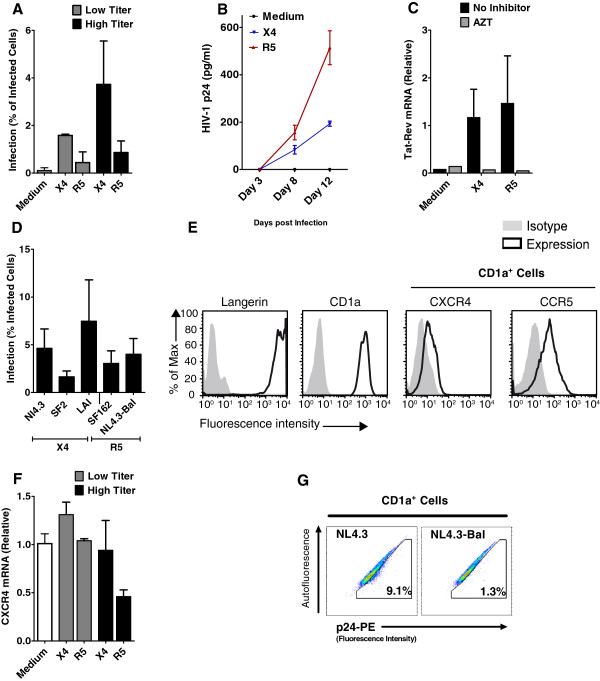Figure 2.

Human primary LCs are infected by X4 HIV-1 variants. (A-B) Human epidermal sheets were pulsed with low or high titers of HIV-1 NL4.3 (X4) or HIV-1 NL4.3-Bal (R5) for 5 hours, washed and cultured for 3 days. (A) Infection of emigrant LCs was determined by intracellular p24 staining or GFP expression in combination with LC-marker CD1a by flow cytometric analysis. The percentage of CD1a+p24+ cells are depicted here as % of infected cells. Error bars represent the mean ± SEM of at least 3 independent experiments. (B) Supernatant of cultured emigrant LCs was collected at day 3, 8 and 12 post-infection and HIV-1 p24 was measured in the supernatant by ELISA. Error bars represent the mean ± SEM of duplicates. (C) Epidermal sheets were pulsed with HIV-1 NL4.3 or HIV-1 NL4.3-Bal in the presence or absence of AZT for 5 hours. At day 3, HIV-1 tat/rev transcription in emigrated LCs was analyzed by real-time qPCR. Error bars represent the mean ± SEM of duplicates. One experiment representative of three is presented. (D) Epidermal sheets were pulsed with different X4 (HIV-1 SF2, LAI and NL4.3) and R5 viruses (SF162 and HIV-1 NL4.3-Bal) and after 3 days infection of LCs was determined. Error bars represent the mean ± SEM of at least 3 independent experiments. (E) Surface expression of HIV-1 coreceptors CCR5 and CXCR4 on immature LCs. Histograms represent at least 3 donors. (F) Epidermal sheets were pulsed with X4 and R5 for 5 hours. After 3 days mRNA expression of CXCR4 was measured in emigrant LCs by real-time qPCR. Error bars represent the mean ± SEM of duplicates. (G) Vaginal LCs were infected with HIV-1 NL4.3 and NL4.3-Bal and infection was measured by intracellular p24 staining. Representative dotplots of one out of two donors are shown.
